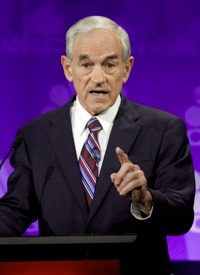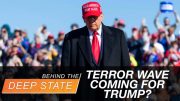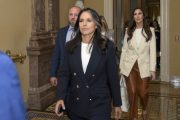
“For Ron Paul to run as an independent,” Fox News Channel’s Juan Williams wrote back on November 4, “could be the biggest, most consequential third party candidacy in American history. Yes, one that is even bigger than Ross Perot’s candidacy was in the 90s.”
Persistent talk about a Ron Paul third party candidacy by some may be an attempt to sabotage Dr. Paul’s GOP candidacy and enable establishment candidates who support banking bailouts and irresponsible foreign military intervention to win the nomination. Paul has stated he won’t run an independent race for the presidency. But serious analysis of the 2012 presidential race indicates that a major independent challenge is all but certain this year without an anti-bailout candidate such as Paul winning the GOP nomination.
Indeed, a significant third party candidacy need not be headlined by Ron Paul. Plenty of third party candidate possibilities dot the political horizon, each of whom could draw 5-15 percent of the popular vote (or more) and a significant percentage of conservative and independent voters. More on those possible candidates later. But first, let’s outline a few basic facts about the 2012 presidential election.
Electoral Fact #1: Obama can’t win 50 percent of the vote in 2012.
Presidents can’t spend a dime under the U.S. Constitution, but they inevitably get the blame or credit for the economy at the polls. Although only Congress can spend money under the U.S. Constitution, Obama mostly got his way with Congress during the financial crisis. Obama backed the Bush TARP bailout that Congress passed just before he took office. While in office, Congress passed his “Stimulus” bill, “Cash for Clunkers,” Dodd-Frank financial regulatory program, and his health care overhaul.
As Presidents get credit or blame for the economy, 2012 will be a severe case of blame. With an unemployment rate hovering at about nine percent for the third year in a row, and no prospects for a quick recovery, Americans are not going to judge themselves better off than four years ago. Obama recognized this after his election. “I will be held accountable. I’ve got four years,” Obama told NBC’s Today show February 2, 2009. “If I don’t have this done in three years, then there’s going to be a one-term proposition.”
Even with a moderate recovery, the unemployment rate will be higher when he leaves office than when he took office. The establishment has known for a year now that this will not be a year for Democrats, so they are betting their campaign donations on candidates who they believe will be the winners. Goldman Sachs employees, who donated to Democrats by a more than three-to-one margin in 2008, have gradually switched parties over the past four years. In the 2012 cycle thus far, Goldman Sachs employee donations have weighed in favor of Republicans by a nearly three-to-one ratio.
Obama’s chief weakness is the economy, but he has another key weakness that a presidential opponent will exploit, whether it be a Republican or third party candidate: He was the choice of pro-bailout “crony capitalists” in 2008, and is still the top Democratic choice of crony capitalists. Goldman Sachs employees donated more than $1 million to Obama’s campaign in the 2008 cycle, more than to any other candidate. Obama remains the top Democratic recipient this time around too, winning more than $50,000 from Goldman Sachs employees. It’s as a reaction to Goldman Sachs-style bailouts, i.e., “crony capitalists,” that both the Tea Party and Occupy Wall Street are arrayed.
Electoral Fact #2: “Crony capitalism” is a giant electoral issue, and growing.
The Tea Party movement that grew out of reaction against the TARP bailout as well as Obama’s “stimulus” and health care agenda differs on a number of accounts with the Occupy Wall Street movement. But while much of the Occupy Wall Street is based upon poor economics, it has some common themes with the Tea Party movement in its opposition to bailouts of big corporations and banks. Both are suspicious of our banking system and the Federal Reserve Bank.
The common causes between Occupy Wall Street and the Tea Party movement could be summed up by October 18 comments by Wikipedia founder Jimmy Wales: “You won’t find a bigger proponent of the free markets and capitalism than me. I think a big part of what people are protesting about and they have the right to protest about is when big companies are failing and they get bailed out and then the management pays itself a bonus out of money that was taken from us in taxes. It’s outrageous,” Wales told the British television station Sky News, a Fox News affiliate. “The idea that because you’re politically connected you’re able to get access to taxpayers’ money and take home a 40 million pound paycheck, it’s just outrageous.” Wales then joked: “Where’s a tent? I’m going to go and protest right now.”
The political nexus between the Tea Party and the Occupy Wall Street is in opposition to the bipartisan bailouts: the $700 billion TARP, the auto industry bailout, the “stimulus” spending for favored industries such as Solyndra, and a Federal Reserve bank bailout program of $16 trillion that dwarfed all others.
Electoral Fact #3: Pro-bailout GOP candidates guarantee a third party candidacy.
Should establishment candidates such as Mitt Romney, Herman Cain, Rick Perry, or Newt Gingrich win the nomination, they would spark a major third party movement in reaction to crony capitalism.
Mitt Romney who backed the TARP bailout in 2008 is the Goldman Sachs candidate of choice for the 2012 cycle thus far, racking up some $367,200 in Goldman Sachs employee donations through the third quarter of 2011. Romney’s other top donors were also elite banks, Credit Suisse Group ($198,750) and Morgan Stanley ($191,800). Romney also received $235,275 from Goldman Sachs employees in 2008, his top source of donations. Romney’s other top contributors in 2008, like this cycle, were also banks: Citigroup Inc ($178,450), Merrill Lynch ($176,125), Morgan Stanley ($170,350), Lehman Brothers ($154,800), UBS AG ($125,150), JPMorgan Chase & Co ($123,800), and so on. If Romney isn’t the clear choice of the “one percent,” then it’s difficult to tell who would be.
Likewise, Herman Cain can’t distance himself from his support for TARP. He’s admitted it on videotape and pronounced it a “win-win for the taxpayer” in print back in an October 20, 2008 syndicated column. As a former Kansas City Federal Reserve Bank chairman, Cain’s job of winning the anti-crony vote becomes impossible.
Texas Governor Rick Perry also backed the TARP bailout in a letter on behalf of the Republican Governors’ Association back in 2008. Shortly after Perry announced his candidacy for President, a top Bank of America official could be heard at a fundraiser saying “we will help you out.” Again, that’s electoral poison for those who oppose crony capitalism.
Former Speaker of the U.S. House of Representatives Newt Gingrich also backed TARP, telling George Stephanopoulos before passage of the bill that “I probably would end up voting reluctantly yes because I think you are given no choice.” Gingrich also endorsed the concept of a Wall Street bailout in a Human Events column, calling his plan a “work-out rather than a bailout.” Gingrich’s plan, he wrote October 1, 2008, would bail out insolvent Wall Street banks. “The taxpayers should be asked to extend these institutions a line of credit until they can get back on their feet, rather than blindly acquire these institutions’ toxic paper. This is the essential difference between a workout and a bailout.” Gingrich’s distinction between a bailout and a “workout” was only a marketing difference rather than a difference on principle.
Gingrich has also backed corporate subsidies of the ethanol industry for decades, and became a paid consultant of the ethanol industry after he left office. The Wall Street Journal noted April 27, 2011 that “Professor Gingrich says his ethanol support is grounded in his lifetime of studying history and intellectual problems, but what about that $312,500 from the ethanol lobby?… We’ve never suggested Mr. Gingrich has been bought off, though of course there wouldn’t be an ethanol lobby to hire Mr. Gingrich if there weren’t politicians like Mr. Gingrich willing to prop it up with taxpayer dollars, tariffs and mandates.”
Electoral Fact #4: Ron Paul is the only Republican who can win voters who oppose “crony capitalism.”
While Ron Paul is not the only Republican who opposed the TARP and other bailouts (Michele Bachmann and Gary Johnson also opposed it), he’s the only GOP candidate currently polling in double digits to have done so.
Perhaps more importantly, Ron Paul’s longstanding opposition to corporate subsidies is a matter of public record. In fact, he’s the only presidential candidate who repeatedly predicted the housing bubble and did his best to prevent it. The strongest Republican case for Ron Paul’s electability may be demonstrated by the fact that a Paul nomination would prevent a three-way race based upon crony capitalism that would likely end in an Obama reelection.
In order to come to this conclusion, one need only consider a few historical races where a strong third party race ended with election of the Democrat. This is precisely what happened in 1912 with Teddy Roosevelt’s Bull Moose Party run, as well as in 1992 and 1996 with H. Ross Perot’s runs for the presidency. In all three cases, the Democrat failed to win a majority of the popular vote but won the election anyway. Bill Clinton was elected twice to the presidency while never winning a majority of the popular vote. In all three cases, crony capitalism was a key issue in the race. Teddy Roosevelt ran on a platform that railed against “false capitalization and special privilege” and sounded very much like the Occupy Wall Street movement of 2011. Ross Perot’s Reform Party railed against pork barrel projects and special favors in the NAFTA and WTO trade agreements, the crony capitalism of that age.
Electoral Fact #5: Ron Paul won’t run third party, but someone else significant almost certainly will.
While it’s almost certain that Ron Paul won’t run as a third party candidate, there are plenty of center-right or libertarian possible candidates waiting in the wings. Here are some possibilities:
- Former government officers: There’s no shortage of former office holders who could generate national headlines with an independent race, from former Minnesota Governor Jesse Ventura (who has talked about a third party run, despite recent remarks threatening to move to Mexico); to former New Mexico Governor Gary Johnson, a libertarian-leaning GOP presidential candidate ignored by the major media; and even former Georgia Republican Congressman and Libertarian Party Presidential nominee Bob Barr.
- Hollywood actors: Other right-leaning candidates could come from Hollywood, such as Clint Eastwood (who was once considered a possible VP pick by the elder Bush), Mel Gibson, or Bruce Willis. There are dozens of Hollywood actors who would have the media coverage and money necessary to make a serious run.
- Paleoconservatives: It’s also possible for a paleoconservative such as Pat Buchanan to make another independent presidential run, or a trade-hawk such as Ross Perot running mate Pat Choate.
- Media Personalities: Media personalities also possess the name recognition to garner significant attention, such as CNBC’s populistic reporter Rick Santelli, independent-minded radio talk show hosts Jerry Doyle or Howard Stern, or even Fox Business Channel’s Judge Andrew Napolitano.
- Austrian School Economists: There’s also a short list of people associated with the Austrian school of economics who could make a run that would draw off the million-plus disgruntled Ron Paul GOP primary votes. A candidacy by EuroPacific Capital CEO Peter Schiff, scholar Tom Woods or AntiWar.com’s Justin Raimondo would probably draw a million or more votes, most of whom would have otherwise gone to Ron Paul in a head-to-head against Democrat Obama.
- Business leaders: Finally, there is a long list of business leaders who could dissent from the Wall Street elitist pack and finance their own independent campaign for President. It need not be Donald Trump, who flirted with a Reform Party run in 2000 as well as a 2012 run as a Republican. There are hundreds of wealthy executives who could mount a serious and well-financed campaign, such as Steve Forbes (who’s already run for President as a Republican), America On-Line Founder Steve Case, or a member of the Walton family fortune (Wal-Mart heirs).
While the vast majority of these possible candidates have no interest in running for President, all it would take to prevent any GOP candidate from winning a majority in the final election is for one to run. There’s no shortage of high profile possible third party candidates who could draw Republican votes from an establishment nominee who has a history of defending crony capitalism. But a Ron Paul candidacy would defeat any center-right or populist third party candidacy by co-opting the anti-crony capitalist vote.
In sum, the Republican Party’s best chance for recapturing the presidency is to nominate Ron Paul.



